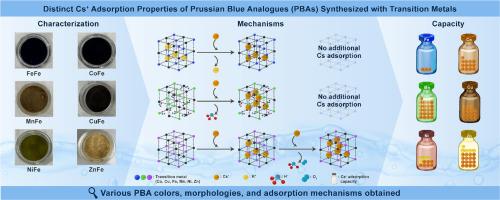当前位置:
X-MOL 学术
›
Water Res.
›
论文详情
Our official English website, www.x-mol.net, welcomes your
feedback! (Note: you will need to create a separate account there.)
Effect of incorporated transition metals on the adsorption mechanisms of radioactive cesium in Prussian blue analogs
Water Research ( IF 11.4 ) Pub Date : 2024-10-26 , DOI: 10.1016/j.watres.2024.122700 Semin Eun, Bokyung Kim, Minsun Kim, Jungho Ryu, Young-Soo Han, Soonhyun Kim
Water Research ( IF 11.4 ) Pub Date : 2024-10-26 , DOI: 10.1016/j.watres.2024.122700 Semin Eun, Bokyung Kim, Minsun Kim, Jungho Ryu, Young-Soo Han, Soonhyun Kim

|
Extensive efforts were made to remove radioactive cesium (137Cs) from the environment, with Prussian blue analogs (PBAs) emerging as highly selective and efficient materials for 137Cs removal. However, limited studies systematically compared Cs+ adsorption across different transition metals in PBA. This study investigates the influence of the choice of transition metal ion (Co, Cu, Fe, Mn, Ni, Zn) on Cs+ adsorption mechanisms and efficiency. PBAs were synthesized and characterized based on their specific surface area, ion exchange capacity, lattice parameter, and defect sites (as indicated by water molecule content). Cs+ adsorption mechanisms varied significantly with transition metals. In CoFe and FeFe PBAs, ion exchange with K+ dominated, while CuFe and MnFe PBAs, with more defect sites primarily used ion exchange between H+ and Cs+. NiFe and ZnFe exhibited enhanced Cs+ adsorption under light irradiation, likely due to their light-absorbing properties facilitating a reduction reaction. The Langmuir adsorption isotherm was applied to model the adsorption behavior, confirming that each performance of PBA depends on the transition metal used. These findings suggest that PBAs with various transition metals can efficiently remove 137Cs under diverse environmental conditions by using distinct adsorption mechanisms.
中文翻译:

掺入过渡金属对普鲁士蓝类似物中放射性铯吸附机理的影响
人们做出了广泛的努力来去除环境中的放射性铯 (137Cs),普鲁士蓝类似物 (PBA) 成为去除 137Cs 的高选择性和高效材料。然而,有限的研究系统地比较了 PBA 中不同过渡金属的 Cs+ 吸附。本研究探讨了过渡金属离子 (Co, Cu, Fe, Mn, Ni, Zn) 的选择对 Cs+ 吸附机理和效率的影响。PBAs 的合成基于其比表面积、离子交换容量、晶格参数和缺陷位点(如水分子含量所示)进行表征。Cs+ 吸附机制随过渡金属而显著变化。在 CoFe 和 FeFe PBA 中,与 K+ 的离子交换占主导地位,而具有更多缺陷位点的 CuFe 和 MnFe PBA 主要使用 H+ 和 Cs+ 之间的离子交换。NiFe 和 ZnFe 在光照射下表现出增强的 Cs+ 吸附,这可能是由于它们的光吸收特性促进了还原反应。应用 Langmuir 吸附等温线对吸附行为进行建模,证实 PBA 的每种性能都取决于所使用的过渡金属。这些发现表明,具有不同过渡金属的 PBA 可以通过使用不同的吸附机制在不同环境条件下有效地去除 137Cs。
更新日期:2024-10-26
中文翻译:

掺入过渡金属对普鲁士蓝类似物中放射性铯吸附机理的影响
人们做出了广泛的努力来去除环境中的放射性铯 (137Cs),普鲁士蓝类似物 (PBA) 成为去除 137Cs 的高选择性和高效材料。然而,有限的研究系统地比较了 PBA 中不同过渡金属的 Cs+ 吸附。本研究探讨了过渡金属离子 (Co, Cu, Fe, Mn, Ni, Zn) 的选择对 Cs+ 吸附机理和效率的影响。PBAs 的合成基于其比表面积、离子交换容量、晶格参数和缺陷位点(如水分子含量所示)进行表征。Cs+ 吸附机制随过渡金属而显著变化。在 CoFe 和 FeFe PBA 中,与 K+ 的离子交换占主导地位,而具有更多缺陷位点的 CuFe 和 MnFe PBA 主要使用 H+ 和 Cs+ 之间的离子交换。NiFe 和 ZnFe 在光照射下表现出增强的 Cs+ 吸附,这可能是由于它们的光吸收特性促进了还原反应。应用 Langmuir 吸附等温线对吸附行为进行建模,证实 PBA 的每种性能都取决于所使用的过渡金属。这些发现表明,具有不同过渡金属的 PBA 可以通过使用不同的吸附机制在不同环境条件下有效地去除 137Cs。


















































 京公网安备 11010802027423号
京公网安备 11010802027423号